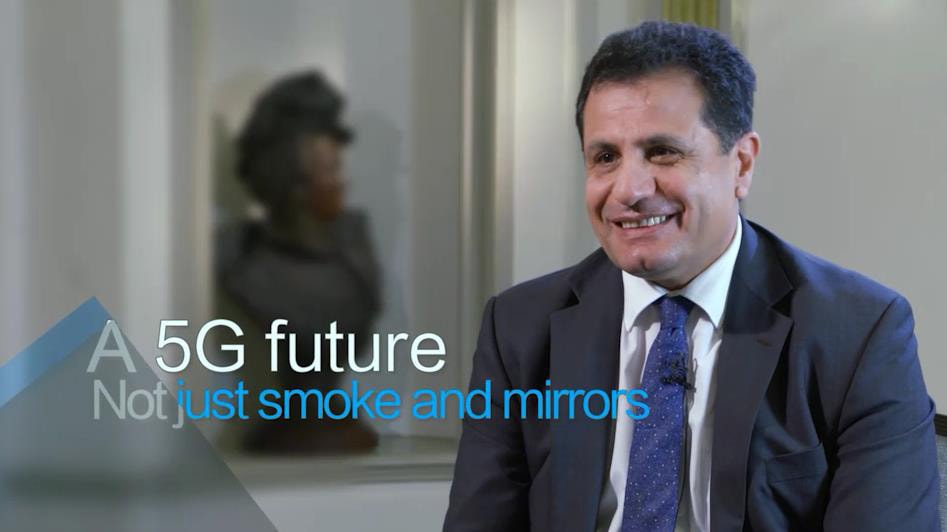A 5G future: Not Just Smoke and Mirrors
5G is the key enabler for high-speed, low-latency wireless broadband services like IoT, AI, VR, AR and connected vehicles. Professor Rahim Tafazolli, Director of 5G Innovation Center and Institute for Communications Systems, explains how 5G technology is evolving and will form the foundation for pervasive wireless business processes in verticals.


By Linda Xu and Gary Maidment
5G is the key enabler for high-speed, low-latency wireless broadband services like IoT, AI, VR, AR and connected vehicles. Professor Rahim Tafazolli, Director of 5G Innovation Center and Institute for Communications Systems, explains how 5G technology is evolving and will form the foundation for pervasive wireless business processes in verticals.
Lucrative 5G services
According to GSMA, 5G could account for as many as 1.1 billion connections by 2025. By then, 5G networks are likely to cover one-third of the world’s population. The impact on the mobile industry and its customers will be profound. 5G is more than a new generation of technologies: It marks a new era in which connectivity will become increasingly fluid and flexible. 5G networks will adapt to applications and performance will be tailored precisely to the needs of the user.
Rahim Tafazolli believes that the demand is there, “We need more capacity because people need to consume more data…The amount of data and Internet connectivity is doubling every 18 months.” Commercially, 5G is a necessity according to Tafazolli, with the B2B space opening up before telcos as a result, “It’s mainly concentrating on services in other vertical industries….the automotive industry, health, government, factories, and smart cities. These are the new income source for operators.”
Tafazolli uses manufacturing as an example. In the future, he says, factories, robots, 3D-printing, advanced materials, and sensors will contribute to increased efficiency and flexibility. By connecting and integrating technologies like IoT, cloud, big data, and cyber security solutions, 5G will enable true digitalization. 5G technologies can play a key enabling role in integrating these technologies and offering a ubiquitous platform for interconnect machines, robots, processes, auto guided vehicles, goods, and remote workers.
Tafazolli explains the application of robots in a factory enabled by 5G connectivity will greatly boost output, “The impact of 5G is to connect robots in a factory working 24/7. It will enhance productivity and efficiency by modernizing manufacturing processes.” He cites the low latency offered by 5G as essential for precision robotics, “So robots or a group of robots can work with each other and collaborate with each other.”
Key elements of 5G
The Federal Communications Commission states that future 5G networks will rely on three key elements: spectrum, infrastructure, and backhaul. A key difference between 5G and earlier generations of mobile technology is that the focus of research is on finding the best techniques to improve spectrum utilization, meaning bits per Hertz per unit area, rather than on improving spectrum efficiency, as in bits per Hertz. This is because improvements in spectral efficiency are constrained by background noise, meaning that improvements through coding and modulation design become more difficult and less effective.
Tafazolli mentions several key 5G spectrum bands, “The radio spectrum, especially below 6 GHz, for which we can develop the technology cost effectively, is very scarce. That is the main reason why huge amount of radio spectrum is required below 6 GHz mainly at 3.5 GHz.” He gives the example of Europe, “Where we have another pioneer band as part of the 5G and that is below 1 GHz, mainly 700 MHz, to provide large coverage cost effectively.” In this case, 3.5 GHz and 700 MHz is complemented by millimetric or centimetric bands. “And that is for environment where we need ultra-high capacity communication systems, like football stadiums or areas where the density of users are several orders of magnitude compared to city centers,” says Tafazolli
Charting 5G’s commercial course
The broad commercial network upgrade to 5G is expected to make its debut in 2020. Events like the 2018 Olympic Games in South Korea and the 2020 Olympic Games in Japan are coming up in the 5G time frame. However, there is still differing timeframes due to disagreements on what exactly 5G means and whether a lot of equipment necessary to operate new networks will be needed well ahead of standards being formalized. In addition, 5G won’t be replacing 4G any time soon, says Tafazolli, “It will work with 4G and complements 4G with the new applications…and increase the capacity of the 4G by a factor of 1,000 times.”
He predicts that following the development of 5G standards in 2017, trial devices, terminals, and network architecture will follow, “And in 2019, the World Radio Conference will decide the frequency bands in millimetric bands, which is a candidate pioneer bands globally agreed. That’s part of spectrum. The first version of the 5G will be deployed as early as 2019.”
He states that 5G will evolve over time and go through different phases, starting with high-capacity, enhanced mobile broadband, which will move to ultra-reliable, low-latency communication, before delivering massive connectivity for devices, “Network architecture, the fixed part of the network, will gradually be replaced by fully programmable software-defined network architecture, which will give that flexibility based on distributed cloud architecture and processing, with artificial intelligence and machine learning algorithms to run the network more intelligently.”




